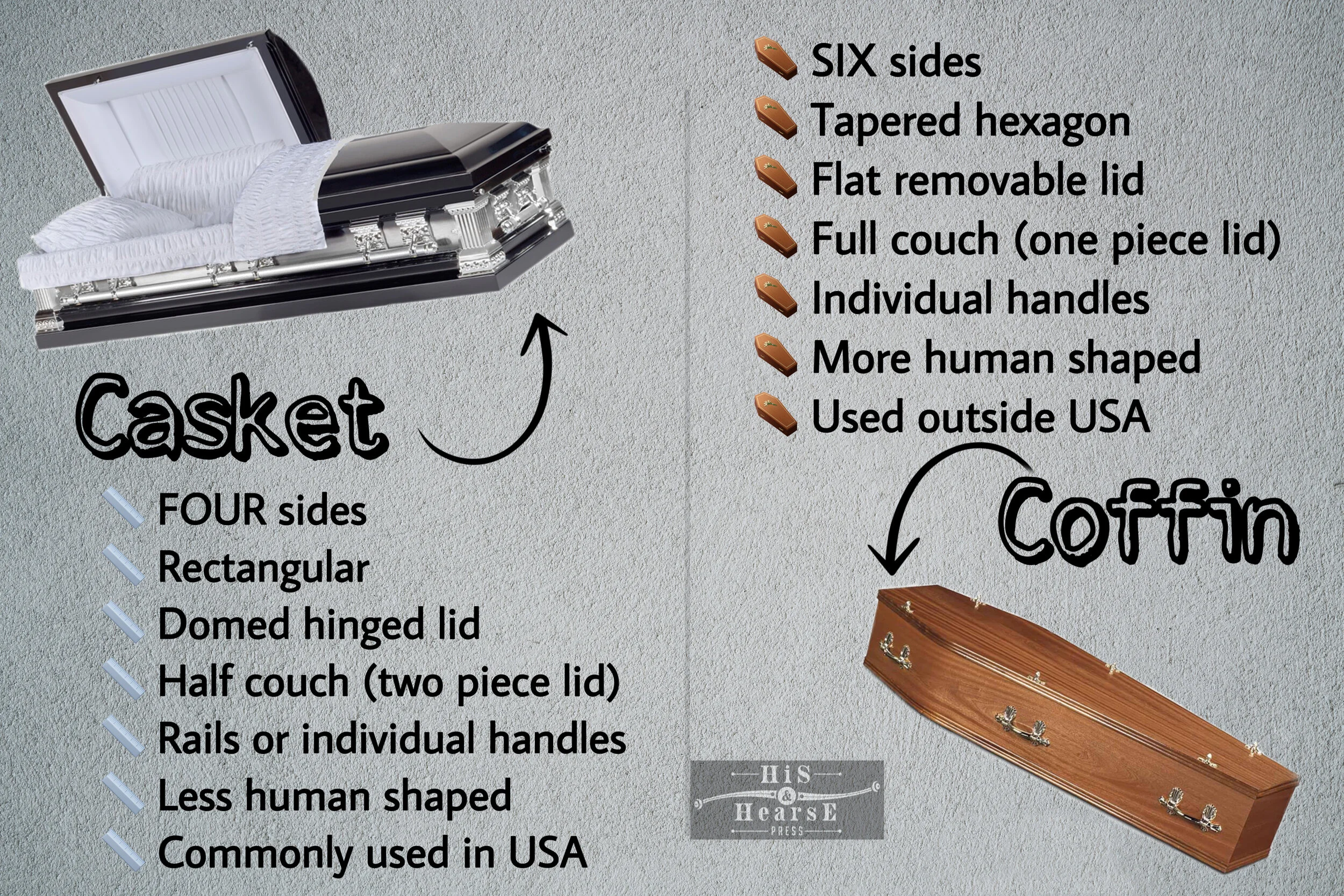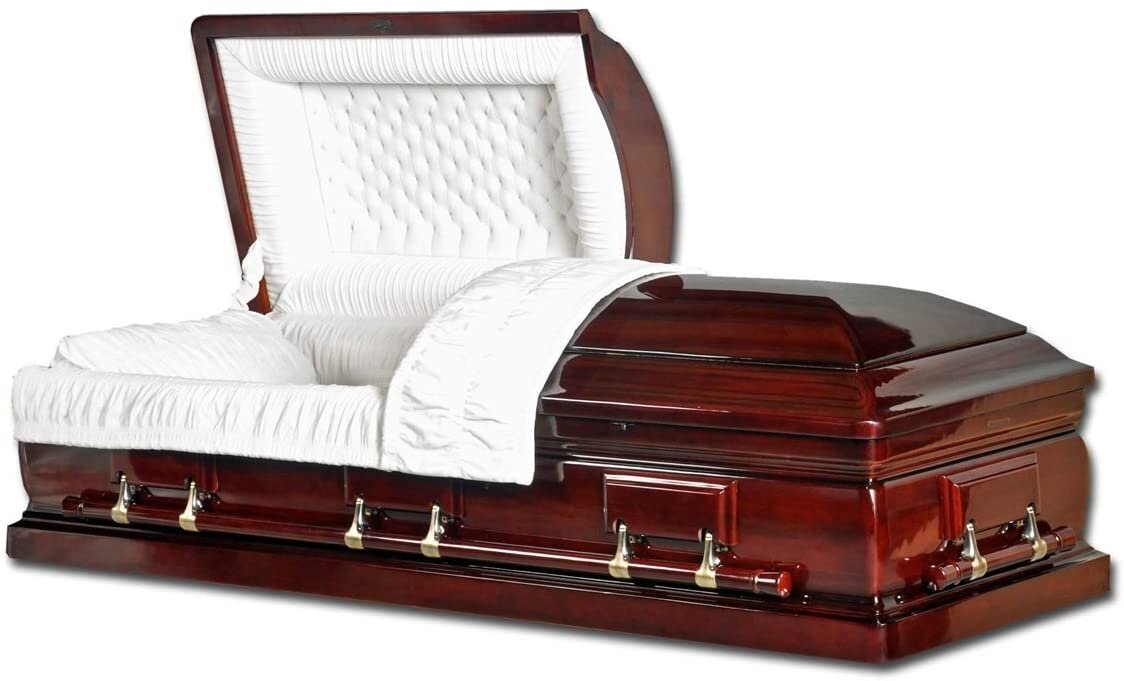Caskets, Coffins, and Other Body Boxes
Containers for every occasion: bury, cremate, rent, or ship!
Caskets are like cars. They come in all makes, models, colors, and features. They’re opened with keys. There are cheap ones, mid-range ones, and expensive ones. There are foreign ones too, which are almost the same, yet slightly and weirdly different. Whether you choose the Pinto or the Rolls Royce, they all get you where you need to go.
First things first: a casket is NOT the same as a coffin. They’re both dead body boxes, but otherwise they’re pretty different. Here’s how:
CASKET
Four sides
Rectangular
Domed hinged lid
Half couch (two piece lid)
Rails or individual handles
Less human shaped
Commonly used in the USA
COFFIN
Six sides
Tapered hexagon
Flat removable lid
Full couch (one piece lid)
Individual handles
More human shaped
Used outside USA
These aren’t hard and fast rules. American caskets sometimes share attributes (like flat removable lids), so don’t get nitpicky. The reason behind the different styles is that folks in the USA thought rectangular caskets looked more like beds than dead body holders. The anthropoidal shape of a coffin evokes a harsher reality. Nowadays, Americans see toe pincher style coffins and think of old horror movies or vampires, even though they’re normal in other parts of the world.
Now that we’ve sorted that out, let’s focus on casket options. There’s a lot to choose from!
Choice #1: Wood or Metal?
Let’s pick metal first. At the top end, you’ve got bronze and copper caskets, which are rust proof and exquisitely made. They’re the most expensive. Picture Michael Jackson, James Brown, and Aretha Franklin’s final send offs: each was in a magnificent bronze Promethean casket, complete with 14 k gold plated hardware and plush velvet interior. These caskets take two weeks to manufacture. They’re hand crafted, polished to a mirror shine, and weigh in at about 310 lbs (140kg). This luxury model costs between $24,000-$30,000.
The rest of us commoners can choose from an array of stainless steel caskets. They’re offered in different gauges (16, 18, and 20) which shows how thick the steel is. A 16 gauge casket is thicker, and priced higher. These caskets are designed with rust inhibitors, but the thinner ones will corrode before the thicker ones.
Metal caskets often include a gasket. That’s a rubber strip that gets sandwiched between the lid and the casket when it’s closed. A crank at the foot end squashes the lid down and locks it, creating an air-tight seal. This is helpful for transporting bodies on airplanes or controlling bodies with communicable diseases. Otherwise, it’s just peace of mind that the environment inside the casket is better protected against outside elements.
Please note that no casket will prevent the decomposition of human remains. Nothing lasts forever! Even gaskets fail over time, and the deceased is already deteriorating because of bacteria and moisture within.
Now for wooden caskets. Some types available are cherry, mahogany, walnut, maple, oak, pine, and poplar. You can get a glossy finish, satin finish, matte finish, or leave it unfinished. Hard woods are more expensive (but can still be cremated!) and softer woods less expensive. Some are made with wood veneers.
Wood caskets are divided into light, medium, and dark. The interiors options are the same as metal caskets. There’s velvet, crepe, and satin, which can be sewn together with slightly different variations (shirred, tufted, ruffled). The colors trend towards white, off white, light pink, and light blue. Nicer caskets have fluffier wedge shaped pillows.
Want customization? We’ve got it. Caskets have varying styles of outer shells and decorative hardware. Most are available as “half couch,” meaning that the lid is in two pieces. Full couch (one piece lid) caskets aren’t as common.
Pick a hobby, vocation, or military branch, and we’ve got several ways to display it on your casket. Some have interchangeable corner pieces featuring a tiny angel, a jumping fish, or a saluting officer. Embroidered panels slot into the rectangle of fabric in the open lid.
Some caskets feature a tiny drawer concealed within the lid, meant to hold letters, photos, and other small mementos for eternity. Most have a small plastic tube screwed into the foot end to hold a tightly rolled piece of paper listing the personal details of the occupant.
Caskets look pretty cushy, don’t they? Well… they’re not meant to be comfortable. The mattresses are a thin layer of batting covered by a piece of fabric. Depending on the model, there can either be cardboard beneath the so-called mattress or an adjustable “bed.”
Beds are simply thin strips of metal in a frame that support the mattress. They can raise or lower to present the body at different heights. Some even tilt side to side. Fancy, but still not as comfy as you’d think. The height mechanism is operated by cranking a casket key (aka ornamental hex key). The same key is also used to lock or seal the casket.
If you don’t want any bells and whistles, you can opt for a plain pine box. The plainest of them all are orthodox Jewish caskets. These caskets are made to very particular, yet simple standards. They’re built under rabbinical supervision (not on the Sabbath), using only kosher materials. There are no metal screws or nails and no animal derived glues. Instead, they’re held together with wooden pegs. The lining is basic, if included at all. Sometimes there are holes drilled in the bottom. This simplicity facilitates the body’s quick return to the earth.
Most Jewish caskets are unadorned except for a wooden Star of David on the lid. While fancy expensive models are available, most people feel the caskets ought to be modest and reflect equality in death. (Bonus fact: Jewish mortuaries regularly add earth from Israel inside these caskets.)
* Plus Sized Options *
A note on casket sizes: internal casket dimensions vary by model and manufacturer, but the standard is around 84” long, 28” wide, and 23” tall. Clearly, they’re not one size fits all. Manufacturers build oversized caskets in increments, extending another 2” wide and 3” long per size increase. Common oversized caskets start at about 31” wide, but I’ve seen caskets online that measured 52” wide.
We have to be cautious in measuring and ordering oversized caskets because, after a certain point, they no longer fit into a standard burial vault. The family may have to purchase an oversized vault, and consequently need an additional grave.
In case you’re wondering, we don’t resort to extreme measures to force a body to fit in a casket. Tall people do NOT get their feet or legs amputated! Instead, we bend their knees, cross their ankles, and remove material from the foot end of the casket. That allows the legs to rest on an angled plane rather than horizontal, adding a couple more inches of legroom.
Choice #2: Cremation Options
Metal caskets cannot be cremated, but wooden ones can (even the most expensive ones get burned!) There’s a range of caskets and alternative containers designed for cremation. These caskets contain materials more conducive to incineration and avoid excess metal (like the adjustable bed frame).
Some cremation caskets look very traditional and others are more minimalist. They can be constructed from fiber board, pressed wood, or plain cardboard. Some have interiors and pillows while some are bare. Families that choose services with a viewing usually opt for a more traditional casket.
Plain cardboard boxes are used for direct cremations without services. We’ll let a family spend a few minutes identifying or saying goodbye to their loved one in a cardboard container if requested. These are not public visitations, but we’ll still try to soften the experience by draping the cardboard with sheets or blankets.
Let’s say you want a nice looking wooden casket for your viewing or funeral, but you don’t want to spend a lot of money on something that’ll get cremated. Did you know there’s a rental option? You can’t choose just any wooden casket for this purpose. The mortuary has one purpose-built “ceremonial” casket for rent. Laws prevent the reuse of caskets, but rentals are an exception because of their design. We reuse only the outer wooden shell.
Inside the shell is a cardboard cremation container with a nice pillow and full lining. After the funeral, we slid the entire cardboard insert and lining out of the wooden shell’s folded down foot panel. We slide a new cardboard insert with lining into the wooden shell, ready for the next occupant. Rental caskets are a good way to save money while keeping a traditional appearance at the funeral.
Alternative containers can also be appropriate for burial when people need to be buried inexpensively. Otherwise they’re chosen by folks who want their casket to biodegrade quickly. We now have several options for “green” burials, such as bamboo, hemp, banana leaf, willow, teak, cork, sea grass, rattan, organic wool/felt/cotton, and recycled cardboard.
Green caskets have a minimal impact on the environment, from construction to decomposition. They’re made from sustainably produced materials and renewable sources. Without the typical handles, hinges, chemical treatments, paints, and veneers, they’re able to biodegrade faster and without releasing toxins into the earth. Some cemeteries allow you to bypass caskets entirely and bury in a shroud.
Choice #3: Transportation Containers
When bodies are shipped to another location, we have a few shipping containers to choose from. Airlines require the use of a protective box: either an air tray or a combo unit. An air tray is for a body inside a casket. The casket rests inside a plywood base, and a cardboard lid slips over the top and sides. We fasten straps across the top to hold it all together. We mark the box with the head end, foot end, and “human remains, handle with extreme care.” It’s a good idea to write the flight itinerary and mortuary contact info on the box, just in case.
If the body will get its casket at the destination, we can ship it without one. That’s what a combo unit is for. It’s like an air tray, with a plywood bottom, cardboard top and sides, and straps. There’s also some extra wall reinforcement and internal straps to protect the remains inside.
If a body needs to be transported out of the country (or domestically but unembalmed), there’s a special airtight metal box called a Ziegler case. This is a 20 gauge zinc coated steel box, unadorned and with no interior, meant to rest inside an air tray. It’s replaced by a casket at the destination. The key feature of this container is its ability to seal hermetically. This satisfies many airline and consular requirements for international shipping.
A newer option for shipping unembalmed bodies uses the Bio Seal system. It’s like a body bag without a zipper. Made from a co-laminated flexible metal material, Bio Seal pouches are like thick heavy duty foil that doesn’t tear. They come on a roll and are cut to length for each body. They’re laid on a table, open like an unzipped sleeping bag. The body lays inside and the excess folds over the top of the body. Once the edges are aligned, a heat sealing tool is used to crimp the three open sides shut. The sealed pouch lays inside the combo unit.
Choice #4: Where To Buy
You’re allowed to purchase a casket anywhere you like, whether that’s the mortuary, Costco, Wal-Mart, or an online retailer. Mortuaries legally cannot refuse to accept outside caskets. That said, mortuaries are pretty careful about quality. Do your homework and understand that a knock off casket may be of inferior quality.
Another option is building or customizing your own, which isn’t recommended unless you’ve got building experience. Caskets must be rigid and leakproof. If it’s going to be cremated, it needs to be combustible and not contain too much metal. You must measure your dimensions carefully to ensure that the body will fit inside AND that the casket will fit inside the burial vault or cremation chamber. It’s also advisable to affix sturdy handles for ease of transport.
Caskets can be expensive. It’s important to consider your budget, weigh your options, and try not to emotionally overspend. If cost is an issue, you can buy an economical casket and personalize it yourself to add meaning and value. I’ve seen several families write messages and draw pictures on their loved one’s casket. Another plastered theirs with stickers. Why not? Good funeral directors will respect your wishes and help you create a fitting tribute, so ask!
Choice #5: Fantasy Coffins
Rather than concluding this lesson on caskets, I’ll send you forth on a journey to discover your ideal container!
Do a Google Images search to find the beautiful fantasy coffins of Ghana.
Which would you choose? Tell me below in the comments!
Veteran funeral director, embalmer, and lifelong bookworm, Louise finally found her purpose: educating and entertaining strangers on the internet about dead bodies and funerals.
Her blog, Read In Peace, combines her passion to educate with fun and humor. She shares tips and useful information about death and funerals, along with lighthearted “dissections” of related books and movies.
Louise is currently working on her first book, a nonfiction guide called Embalming For Amateurs.


































